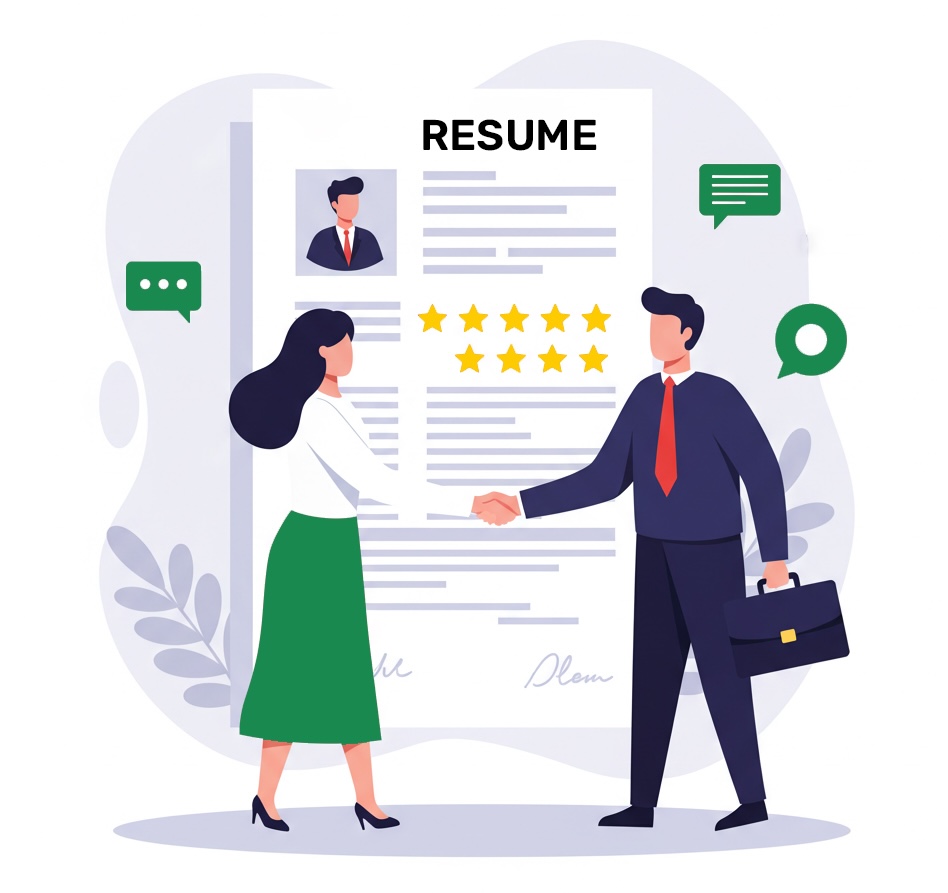Posted On22 Jul 2025
Updated On21 Jul 2025
Tailoring your resume doesn't have to be intimidating or time-consuming. In fact, it's one of the simplest ways to instantly improve your chances of landing interviews. You're not rewriting your life story for every job; you're just reshaping how you present it to better match what the company needs. Think of it like choosing the right outfit for an event: you're still you, just positioned appropriately for the occasion.
The good news is that tailoring isn't that difficult. With a few smart (and quick) edits, like adjusting your summary, reorganizing your bullet points, and emphasizing the right skills, you can build a resume that feels both relevant and personal. Most people spend more time deciding what to watch on Netflix than it takes to tailor a resume properly. Today, I'll walk you through exactly how to tailor your resume to a job step by step, so you don't get passed over by hiring managers or filtered out by AI-powered applicant tracking systems (ATS). Let's make sure your resume actually speaks the language of the job description.
Why You Must Tailor Your Resume
Gone are the days when one-size-fits-all resumes worked. Recruiters today expect alignment, especially as more companies lean on applicant tracking systems and AI screening tools to pre-filter candidates. A tailored resume signals that you've read the job description, understood it, and thoughtfully responded to it.
Dangers of Generic Resumes
Most job seekers create one version of their resume and blast it to dozens of job postings ("Easy Apply" button, I see you!).
This often results in radio silence, especially in today's hyper-competitive job market. Recruiters don't see alignment, ATS software doesn't spot keywords, and your resume lands in the rejection pile.
Tailored Resumes Show Better Results
When you tailor your resume, you:
- Match the job description's language and requirements
- Increase your chances of passing ATS filters
- Show the hiring manager you "get it"
In fact, research shows that tailoring a resume boosts interview chances by up to 70%.
How to Tailor Your Resume to a Job

Tailoring your resume doesn't mean rewriting it from scratch each time. It means adjusting the structure, language, and focus to align with what the employer is asking for. Once you do it a few times, this will get easier.
Let's break it down.
Read the Job Description Carefully
Before getting started on your resume editing, read the job description carefully (like your career depends on it, which it does) and highlight the following:
- Job title
- Necessary skills
- Required qualifications
- Job responsibilities
Make a list of key terms and repeated phrases, which will become your personalization blueprint.
Customize Your Resume Summary
This section should reflect the core theme from the job posting.
In the past, resume summaries were optional or even discouraged, especially for early-career professionals (these were replaced with resume objectives). But with the rise of applicant tracking systems and fast-paced recruiter reviews, the summary section has become a strategic space to make your case quickly. It tells the reader within seconds who you are and what you bring to the table. So, use a summary and use it wisely. A well-crafted resume summary improves 'scannability' and can steer attention to the most relevant parts of your experience.
That said, it shouldn't become your entire resume crammed into four lines. It should be sharp, targeted, and informative. Think of it as a handshake and an elevator pitch rolled into one. The summary isn't the place to dump a thesaurus-worth of vague buzzwords. It should be confident and specific, but never bloated.
Generic Summary (❌ Don't do this)
Dynamic and enthusiastic project management professional with extensive experience in leading cross-functional teams, collaborating across departments, and implementing project delivery solutions in fast-paced environments. Demonstrates a strong commitment to stakeholder success and continuous improvement. Possesses excellent communication, organizational, and problem-solving skills.
Tailored Summary (✅ Yes, please)
Project Manager with 10+ years' experience leading agile teams across three Fortune 500 companies. Known for reducing delivery times by 15% and enhancing stakeholder satisfaction by 30% through data-driven process improvements.
A tailored summary like this isn't just shorter. It's stronger and it speaks to the job description with measurable results and industry-relevant language.
PRO TIP: While important, don't obsess over your summary. Treat it as a filter and write for clarity, not applause.
Align Your Work Experience to the Job
Use the Professional Experience section to showcase which parts of your career history best align with the role you are targeting. And here is how to do this.
Prioritize Relevant Past Roles
Don't list every job you've ever had. Highlight roles that are most relevant to the one you're applying for. That said, there are exceptions to the '15-year rule,' which suggests only including roles from the past 15 years. If you worked in a role that directly connects to the current position (even if it was 20 years ago), it can still be worth including. This is especially true for federal positions, military roles, or government-related work, where a complete history is often required. In such cases, keep descriptions brief, using 2-3 bullet points to preserve space and flow.
Mirror the Language of the Job Posting
Pay close attention to the terms the company uses. If the job posting says "budget oversight" instead of "financial management," mirror that wording in your resume. If it says "CRM," use the acronym. If it spells out "Customer Relationship Management," follow suit. The safest bet? Use the same form the job posting uses, or mention both when relevant (e.g., "CRM (Customer Relationship Management)"). This improves alignment and helps your resume pass ATS filters more reliably.
Language is powerful, so even if your experience is spot-on, failing to use the company's preferred terminology can result in a missed connection - or worse, a missed opportunity.
Quantify Achievements
Tailoring is not about stuffing your resume with keywords. Hiring managers are drawn to tangible, quantifiable outcomes. Use real numbers and show scale and success:
- Reduced costs by 18% through streamlined procurement processes.
- Led cross-functional teams of 12+ in Agile sprints, delivering three major projects 15% ahead of schedule.
Word of caution! Do not add random dollar signs and percentages just to create visual impact. Listing your company's annual revenue or total headcount (if it doesn't connect directly to your own work) rings hollow. Recruiters can spot when metrics are fluffed and irrelevant.
Also, many hiring managers are growing skeptical of excuses, such as "...metrics weren't tracked" or "I signed an NDA." Yes, these situations do occasionally happen, but it's still your responsibility to offer context. If you can't share sensitive data, you can still quantify results in other ways.
Here are three quick strategies to uncover or approximate your metrics:
- Estimate the size or volume of what you managed (e.g., "supported a team of 10 engineers" or "processed 50+ invoices weekly").
- Reflect on before-and-after outcomes (e.g., "cut response time from 48 hours to 12" or "improved customer satisfaction scores").
- Ask former teammates or check past performance reviews for measurable accomplishments you may have forgotten.
Recruiters aren't looking for perfection, but for clarity, credibility, and impact. To deliver this, use the bullet points to tell a story of active performance instead of passive participation.
Highlight Matching Skills in the Skills Section

If the job mentions certain tech, apps, tools, or proficiencies (for example - Salesforce, Python, Adobe Suite), include them. Match both hard and soft skills where applicable.
Keep it skimmable:
Skills: Agile Project Management | Stakeholder Engagement | Jira | MS Project | Cross-Functional Team Leadership
In some cases, however, your current skill set doesn't perfectly align with the posting. So, what do you do?
First, never lie on a resume. Saying you know something you don't can quickly backfire during an interview or a technical assessment. Instead, try shifting the focus to the fact that you're learning the necessary skill and are about to be certified in it (if that is the case, of course). For example:
Skills: SQL (in progress), Adobe Illustrator (beginner, self-learning), Python Basics (Coursera certification expected Aug 2025)
This demonstrates initiative and honesty, which recruiters value. Just be sure you're ready to talk about these skills during the interview.
If, however, your current skills mismatch the role too significantly, it's often better to focus your efforts on positions more aligned with your background. In today's hiring environment, recruiters expect candidates to meet about 90–100% of the required hard skills before shortlisting. Yes, exceptions so exist (especially for high-potential roles or internal promotions), but if you're applying cold, alignment is crucial.
Skill-based hiring is expected to dominate recruitment in 2026. It's no longer your diploma that matters, but your capabilities. Companies now deploy AI-powered skill checkers (these include automated quizzes, simulations, or timed projects) to validate abilities claimed by applicants. These checkers are surprisingly good at detecting bluffs, so if you're tempted to 'cheat' your way past the skills, don't - it's just not worth the risk.
Instead, be transparent and proactive and show that you're a fast learner and already doing the work of closing your skill gaps. That's what recruiters are really looking for: someone who's ready to grow without pretending to already know it all.
Tailor Education and Certifications
Education is often non-negotiable. If the role is asking for a specific degree or credential, list it exactly as stated if you have one, or move to the next role. Chances are, the degree will be listed as part of a "knockout question" on the application anyway.
If you're pursuing a certification, indicate its progress like this:
PMI-ACP Certification (In Progress)
And if your coursework aligns with the job, especially for early-career applicants, add those relevant classes under your degree.
Here is a great, very up-to-date article on how to list education and degrees on your resume (or how to detail this section if you don't have a college degree).
Adjust Formatting for ATS
Even the best hyper-tailored resume won't work if the ATS can't read it. Here's how you make sure your resume doesn't get lost in the ATS maze:
1️⃣ Avoid text boxes, images, sidebars, logos, photos, and complex tables
2️⃣ Use standard section headers, such as Summary, Experience, Education, Skills (don't get creative with phrasing, please!)
3️⃣ Submit/upload your resume as .doc, .docx, or .pdf, unless another format is explicitly requested
4️⃣ Bonus tip: Run your resume through a free ATS checker to catch potential formatting issues.
Tailoring by Industry
Different niches speak different languages. Tailoring your resume means learning and utilizing that language.
Tech
Focus on platforms, tools, apps, and quantifiable results. Use keywords like "DevOps," "Scrum," and "CI/CD". Use your resume to show how your work impacted product delivery, efficiency, or user growth. Numbers win here - such as the number of onboarded users, bugs reduced, or deployments increased.
Education
Resumes in education benefit from structure, certifications, and metrics like student performance. Highlight curriculum development, differentiated instruction, and involvement in academic committees. Use terms like "standards-aligned," "IEP implementation," or "formative assessments."
Healthcare
For clinical or administrative healthcare roles, compliance and certification are very important; that's why you should emphasize familiarity with HIPAA, EMR systems (like Epic), and patient care outcomes. Don't skip soft skills (communication, collaboration, and empathy), which are often key hiring criteria.
PRO TIP: Use NACE's research to identify soft skills that align with specific industries.
Tailoring for Experience Level: Entry-Level to Executive

Tailoring also depends on WHERE you are in your career journey.
Entry-Level
- Emphasize relevant coursework, internships, volunteer roles
- Use academic or project achievements to showcase job-ready skills
- Include a clear objective or summary statement tailored to the job
Mid-Level
- Focus on progression and promotions
- Balance technical skills with leadership examples
- Tailor for job scope: managing teams, budgets, timelines
Executive
- Use a branded summary statement that reflects strategic impact
- Showcase P&L responsibility, board engagement, and leadership
- Tailor for industry and scale (e.g., "Fortune 500" vs. "high-growth startup")
At each of these levels, tailoring your resume involves shaping your career story to demonstrate readiness for the next challenge.
Using LinkedIn and Your Resume Together
Your resume and LinkedIn profile don't need to be identical, but they must be consistent with each other.
- When applying to a job, update your LinkedIn headline to match the role: “Marketing Leader | B2B SaaS | SEO & Demand Generation | Team Builder”
- Your LinkedIn About section can highlight accomplishments tailored to your target industry or job type. Recruiters will look.
- Create a tailored application for a specific role? Upload your resume to your LinkedIn profile's "Featured" section. You can also add links in your About section using tools like Dropbox or Google Drive (set to view-only).
- Use recommendations strategically: Tailored resumes work best when reinforced with social proof. Request LinkedIn recommendations that align with the themes you're emphasizing, like leadership, innovation, or client impact.
- Finally, make sure your LinkedIn profile photo, background image, and activity all reflect the industry and seniority level you're targeting. Tailoring is holistic, and it doesn't end at the resume.
Common Mistakes When Tailoring Your Resume
❌ Keyword stuffing: Adding every buzzword from the job ad may trick ATS, but it won't impress a human. Ensure that your skills and experience genuinely align with the keywords you use.
❌ Copy-pasting the job description: This is lazy, obvious, and ineffective. Use the job description as a guide, not a script.
❌ Neglecting soft skills: Don't just focus on tools and hard skills. If the job emphasizes "collaboration," "problem-solving," or "leadership," those qualities need to appear in your achievements.
❌ Forgetting to tailor the cover letter: While the focus here is on resumes, don't overlook your cover letter. It's a prime place to reinforce the match between your background and the job.
How Often You Should Tailor Your Resume
The perfect answer: for every job application. But realistically, aim to tailor your resume:
- For each different type of role (e.g., Product Manager vs. Program Manager)
- For any job you truly care about
- Whenever you're applying to a company known for being selective
You can create "master" versions of your resume for each job category, then fine-tune from there.
Real-Life Example: Before and After
Let's say you're applying for this role:
Senior Marketing Manager – Healthcare Tech
Seeking a data-driven leader with B2B SaaS marketing experience, SEO expertise, and team leadership skills.
Before
Professional Summary:
Experienced marketing leader with a background in consumer products and branding. Skilled in event planning and public relations.
Work History:
- Managed 10 product launches for various CPG companies
- Coordinated promotional campaigns and PR events with positive outcomes
After Tailoring
Professional Summary:
Marketing manager with 8+ years' experience in B2B SaaS. Drives growth through SEO, content marketing, and cross-functional team leadership; with proven results in healthcare tech space.
Work History:
Developed and executed SEO strategy that increased organic traffic by 62% in 6 months
Led a 5-person marketing team to roll out a product suite for a healthcare SaaS firm, generating $1.2M in revenue
Final Thoughts from a Resume Pro
Tailoring your resume isn't about being manipulative. It's about being relevant.
In today's job market, recruiters spend seconds scanning resumes. If your document doesn't reflect what they're looking for, they'll move on, even if you're perfectly qualified.
Take the extra 15 minutes to tailor your resume; it could mean the difference between getting ghosted and getting hired.
And if you're unsure where to start, Resumeble offers one-on-one support with one of our professional writers, who specialize in crafting tailored, ATS-optimized resumes that work.
Ready to stand out? Let's talk.


